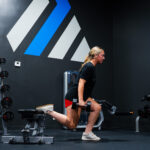Sports Specific Training for Peak Athletic Performance
In today’s competitive sports world, general workouts aren’t enough. To truly excel, athletes need sports specific training—tailored to the exact physical and mental demands of their sport.
Whether you’re a soccer player, swimmer, or baseball pitcher, this type of training bridges the gap between the gym and the game. It enhances performance, minimizes injury risk, and helps athletes move with purpose.
Let’s explore what makes sports specific training so effective and how to incorporate it into your routine.
What Is Sports Specific Training?
Sports specific training is a method that mimics the movements, energy systems, and skills used in a particular sport. Rather than just lifting weights or running laps, athletes train with drills and exercises that translate directly to their on-field performance.
For example:
-
A basketball player works on explosive jumping and lateral movement.
-
A baseball pitcher trains shoulder stability and rotational core power.
-
A sprinter emphasizes short bursts of max-effort speed.
This principle is known as training specificity—a key idea in sports science backed by NSCA.
Why General Training Falls Short
General fitness builds a foundation, but it doesn’t fully prepare athletes for their sport’s unique challenges. Here’s why:
-
It may neglect movement patterns required in competition.
-
It doesn’t build reactive agility or decision-making under pressure.
-
It often overlooks the specific energy systems used (aerobic vs. anaerobic).
That’s where sports specific training comes in—it prepares you for real game scenarios.
Benefits of Sports Specific Training
1. Improved On-Field Performance
Training in a way that replicates your sport boosts speed, strength, and skills that matter most.
2. Injury Prevention
By reinforcing sport-specific movement mechanics, athletes reduce overuse and traumatic injury risks.
3. Increased Confidence
Practicing game-like drills builds trust in your body and skills when it matters most.
4. Efficient Use of Training Time
Every drill serves a purpose—maximizing your results in less time.
Core Components of Sports Specific Training
Each program varies depending on the sport, but most include these five pillars:
1. Movement Pattern Training
Train movements, not just muscles. Focus on:
-
Acceleration and deceleration
-
Cutting and pivoting
-
Jumping and landing mechanics
These help build body awareness and control in live play.
2. Energy System Conditioning
Different sports rely on different fuel systems:
-
Soccer: mostly aerobic with anaerobic bursts
-
Wrestling: high-intensity anaerobic
-
Tennis: repeated short explosive bouts
Your conditioning should match your sport’s demands.
3. Functional Strength
Rather than isolating muscles, use compound, athletic lifts that enhance real-world force output:
-
Trap bar deadlifts
-
Bulgarian split squats
-
Rotational cable presses
4. Skill Transfer Drills
Blend physical training with game skills. Example: dribble through cones while sprinting for soccer.
This reinforces motor patterns under fatigue and pressure.
5. Recovery and Mobility
Proper rest, mobility work, and soft tissue care maintain movement quality and reduce injury risk.
Sample Weekly Plan for Sports Specific Training
| Day | Focus |
|---|---|
| Monday | Lower body + acceleration drills |
| Tuesday | Upper body + agility + skills |
| Wednesday | Active recovery + mobility |
| Thursday | Full body power + sport conditioning |
| Friday | Skills under fatigue + core stability |
| Saturday | Light skills or game simulation |
| Sunday | Rest and recovery |
Each session includes warm-ups, cool-downs, and mental preparation.
Sports Specific Drills by Sport
Soccer
-
Cone dribble to sprint
-
Zig-zag shuffles with ball control
-
Reaction-based passing drills
Baseball
-
Medicine ball rotational throws
-
Shoulder stability with bands
-
Sprint-to-swing transitions
Basketball
-
Defensive slides to vertical jump
-
Fast-break simulations
-
Plyometrics with ball handling
Tennis
-
Lateral shuffle with stroke mimic
-
Interval sprints with racket swings
-
Core work with rotation
These drills reinforce in-game movement and improve conditioning in sport-relevant ways.
Tools and Equipment to Use
Depending on your sport, these tools can enhance sports specific training:
-
Resistance bands (great for joint control)
-
Weighted vests or sleds (boost force production)
-
Agility ladders and cones (develop footwork)
-
Medicine balls (train rotational power)
-
Plyo boxes (enhance jump mechanics)
Use tools that support—not distract from—your goal movements.
Mistakes to Avoid
Even good intentions can backfire if training isn’t applied properly. Avoid these common mistakes:
-
Too much complexity: Drills should mimic sport tasks, not circus tricks.
-
Neglecting recovery: Training hard without recovery leads to overuse injuries.
-
Not progressing over time: Gradually increase intensity to continue adapting.
-
Copying other athletes: Your sport, position, and body are unique.
Stick to a plan that aligns with your goals and sport demands.
Where to Get Support
Want help crafting a personalized sports specific training plan? At Next Level Athletics, expert coaches offer custom programs tailored to your sport, goals, and season.
Training with a coach ensures accountability, progression, and optimal results.
Conclusion: Train With Purpose
To succeed in competition, your training must match your sport. That’s why sports specific training is the smart choice for athletes who want to perform at their best.
It’s not just about working harder—it’s about training smarter.


Recent Comments